Leadership Theories: Traits, Behaviors, and Cultural Influences
VerifiedAdded on 2021/05/31
|41
|2583
|451
Report
AI Summary
This report delves into the evolution of leadership theories, beginning with early approaches that focused on distinguishing traits of leaders. It explores the 'Great Man' approach and subsequent research that identified personality traits, intelligence, and emotional intelligence (E.Q.) as key factors influencing leadership effectiveness. The report then transitions to leadership behaviors, examining autocratic and democratic styles, along with the impact of cultural contexts, such as Asian leadership styles and the paternal and sheikocratic approaches. The Leadership Grid and Vertical Dyad Linkage Model are also discussed, providing a comprehensive overview of leadership concepts and their practical applications. The report includes examples of successful leaders and their leadership styles.

Paraphrase This Document
Need a fresh take? Get an instant paraphrase of this document with our AI Paraphraser

Discuss early approaches to understanding leader
Explain how leadership is understood by what lea
are
Identify the traits commonly associated with leade
Explain how leadership is understood by what lea
do
Understand what hinders managers from becomin
leader
Recognise approaches to changing leadership beh
Explain how leadership is understood by what lea
are
Identify the traits commonly associated with leade
Explain how leadership is understood by what lea
do
Understand what hinders managers from becomin
leader
Recognise approaches to changing leadership beh
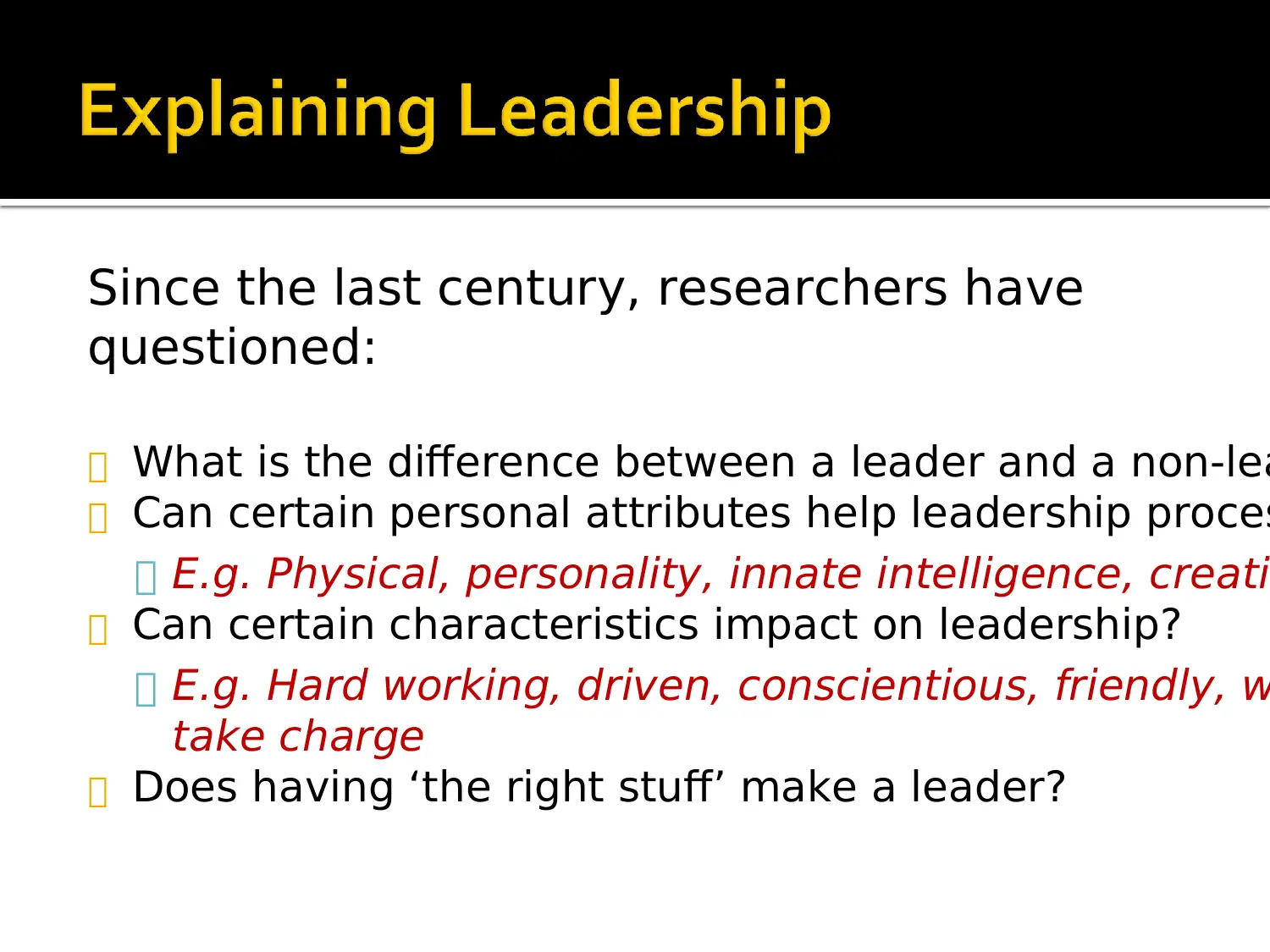
Since the last century, researchers have
questioned:
What is the difference between a leader and a non-lea
Can certain personal attributes help leadership proces
E.g. Physical, personality, innate intelligence, creati
Can certain characteristics impact on leadership?
E.g. Hard working, driven, conscientious, friendly, w
take charge
Does having ‘the right stuff’ make a leader?
questioned:
What is the difference between a leader and a non-lea
Can certain personal attributes help leadership proces
E.g. Physical, personality, innate intelligence, creati
Can certain characteristics impact on leadership?
E.g. Hard working, driven, conscientious, friendly, w
take charge
Does having ‘the right stuff’ make a leader?
⊘ This is a preview!⊘
Do you want full access?
Subscribe today to unlock all pages.

Trusted by 1+ million students worldwide
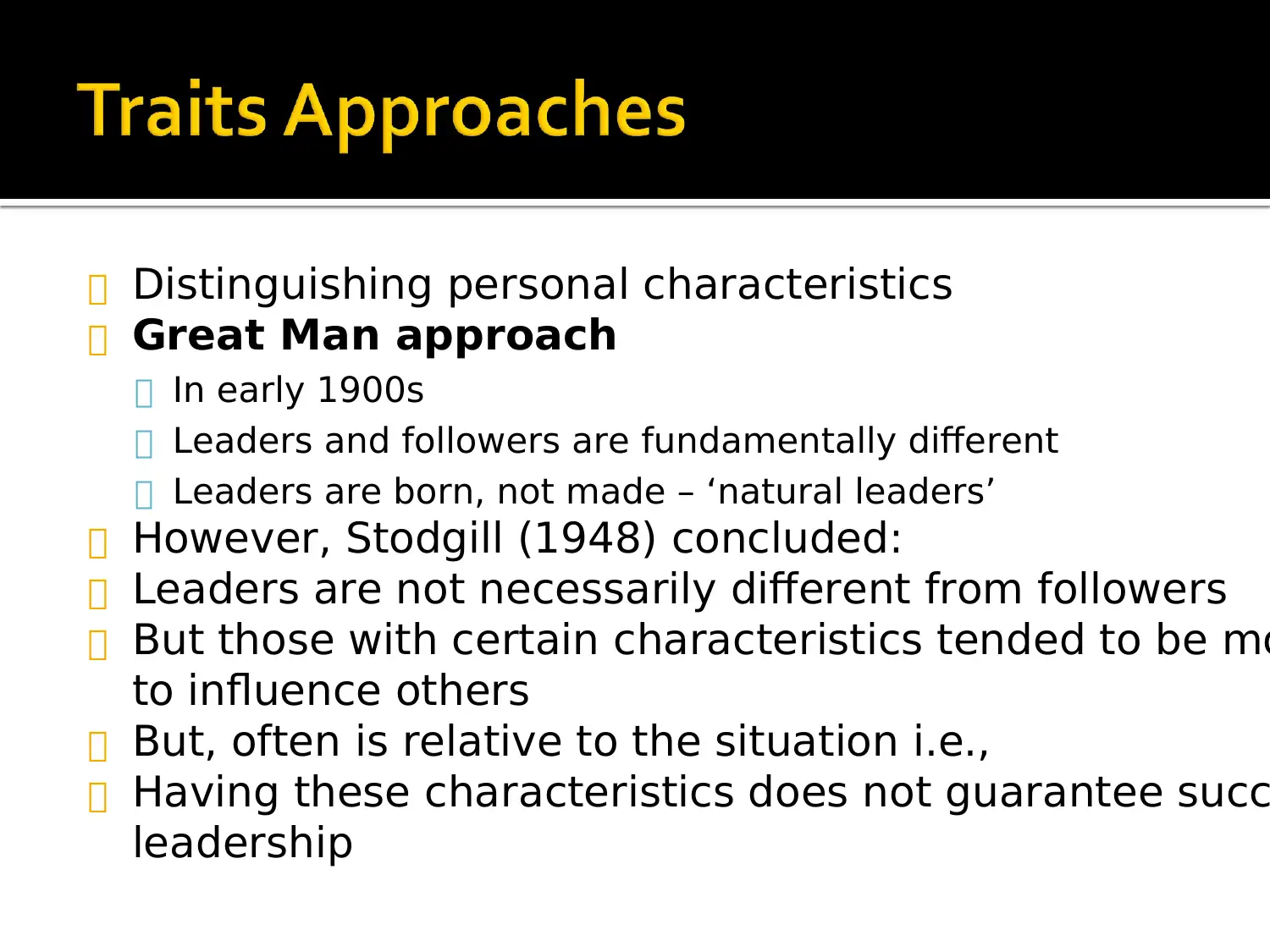
Distinguishing personal characteristics
Great Man approach
In early 1900s
Leaders and followers are fundamentally different
Leaders are born, not made – ‘natural leaders’
However, Stodgill (1948) concluded:
Leaders are not necessarily different from followers
But those with certain characteristics tended to be mo
to influence others
But, often is relative to the situation i.e.,
Having these characteristics does not guarantee succ
leadership
Great Man approach
In early 1900s
Leaders and followers are fundamentally different
Leaders are born, not made – ‘natural leaders’
However, Stodgill (1948) concluded:
Leaders are not necessarily different from followers
But those with certain characteristics tended to be mo
to influence others
But, often is relative to the situation i.e.,
Having these characteristics does not guarantee succ
leadership
Paraphrase This Document
Need a fresh take? Get an instant paraphrase of this document with our AI Paraphraser
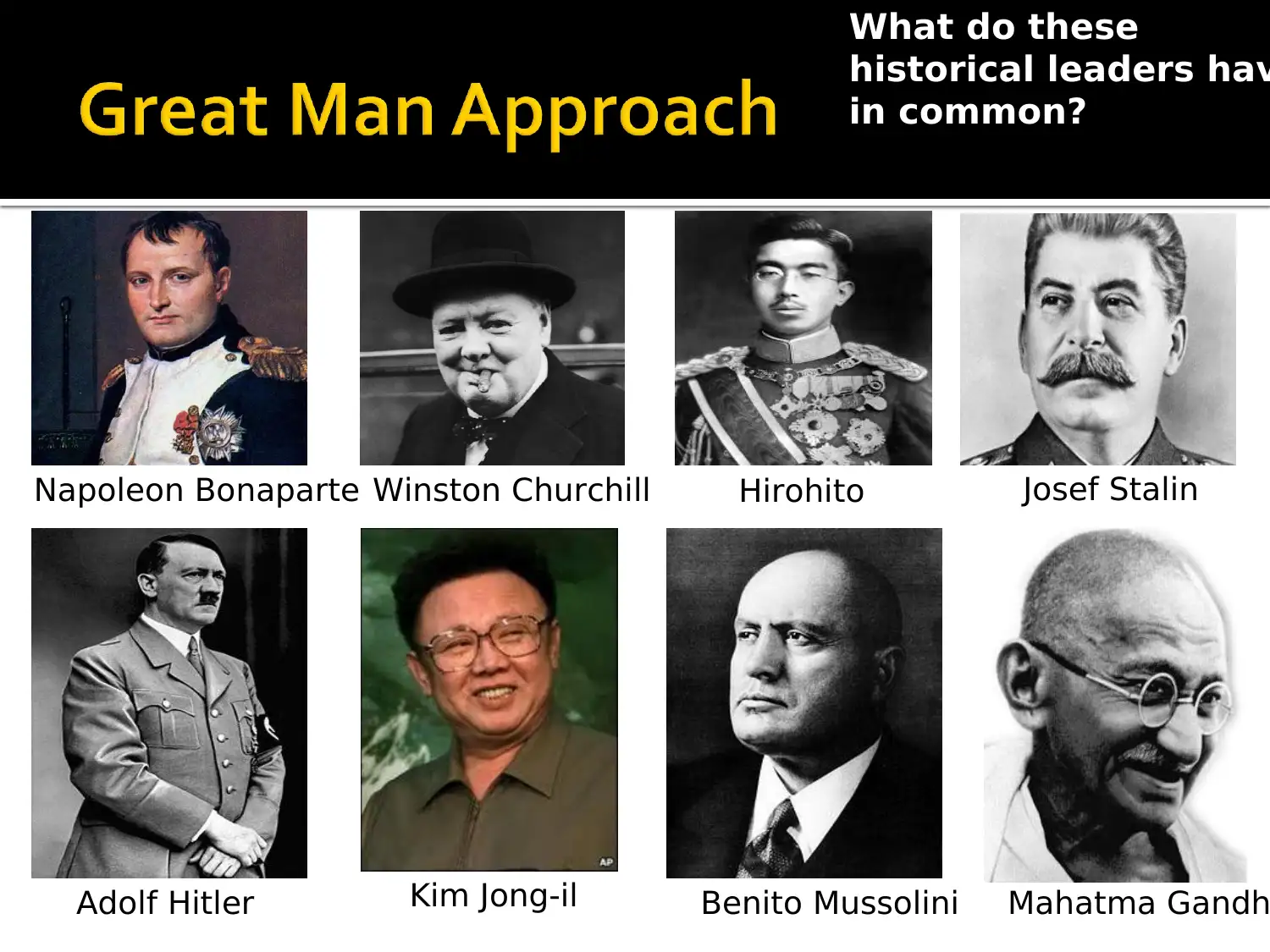
Napoleon Bonaparte
Adolf Hitler
Winston Churchill Josef StalinHirohito
Benito Mussolini Mahatma Gandh
What do these
historical leaders hav
in common?
Kim Jong-il
Adolf Hitler
Winston Churchill Josef StalinHirohito
Benito Mussolini Mahatma Gandh
What do these
historical leaders hav
in common?
Kim Jong-il

⊘ This is a preview!⊘
Do you want full access?
Subscribe today to unlock all pages.

Trusted by 1+ million students worldwide
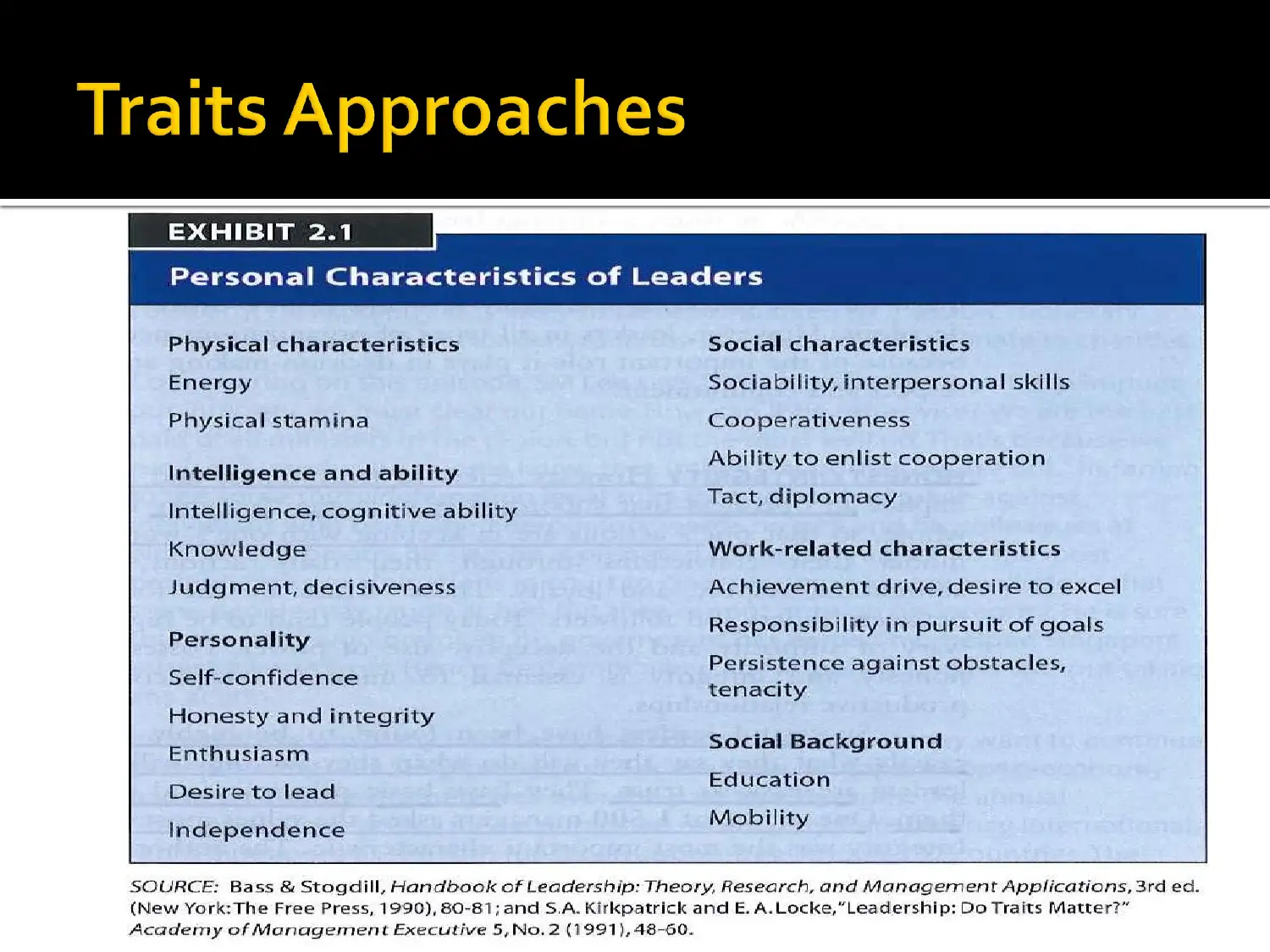
Paraphrase This Document
Need a fresh take? Get an instant paraphrase of this document with our AI Paraphraser

Ritesh Agarwal (27 yo)
OYO Rooms, India
Leandro Leviste (25 yo)
Solar, Philippines
Abdallah Absi(28 yo)
Zoomal, Lebanon
Rika Shiiki(23 yo)
AMF, Japan
Founder
and CEO of
their
company
OYO Rooms, India
Leandro Leviste (25 yo)
Solar, Philippines
Abdallah Absi(28 yo)
Zoomal, Lebanon
Rika Shiiki(23 yo)
AMF, Japan
Founder
and CEO of
their
company
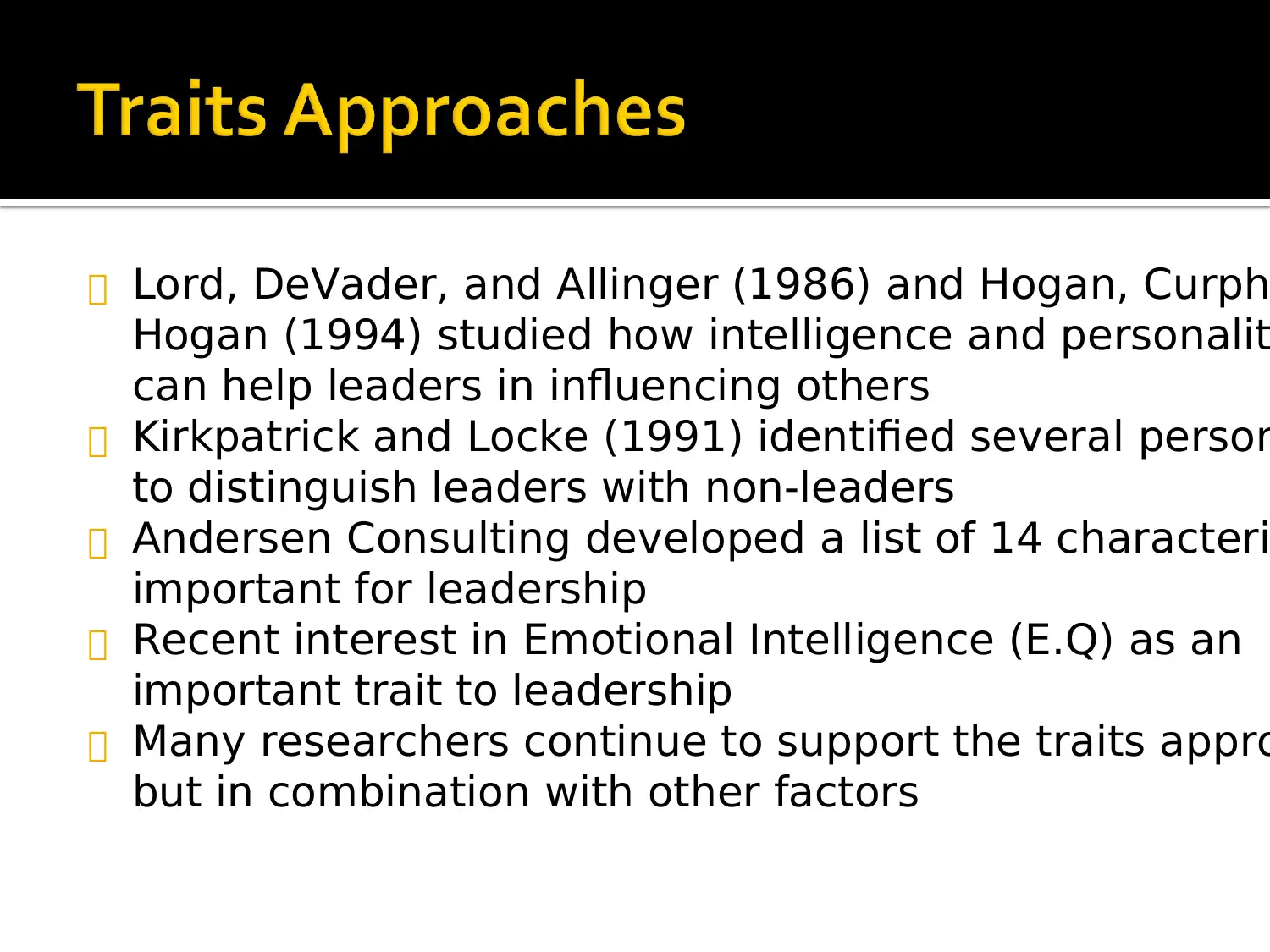
Lord, DeVader, and Allinger (1986) and Hogan, Curph
Hogan (1994) studied how intelligence and personalit
can help leaders in influencing others
Kirkpatrick and Locke (1991) identified several person
to distinguish leaders with non-leaders
Andersen Consulting developed a list of 14 characteri
important for leadership
Recent interest in Emotional Intelligence (E.Q) as an
important trait to leadership
Many researchers continue to support the traits appro
but in combination with other factors
Hogan (1994) studied how intelligence and personalit
can help leaders in influencing others
Kirkpatrick and Locke (1991) identified several person
to distinguish leaders with non-leaders
Andersen Consulting developed a list of 14 characteri
important for leadership
Recent interest in Emotional Intelligence (E.Q) as an
important trait to leadership
Many researchers continue to support the traits appro
but in combination with other factors
⊘ This is a preview!⊘
Do you want full access?
Subscribe today to unlock all pages.

Trusted by 1+ million students worldwide
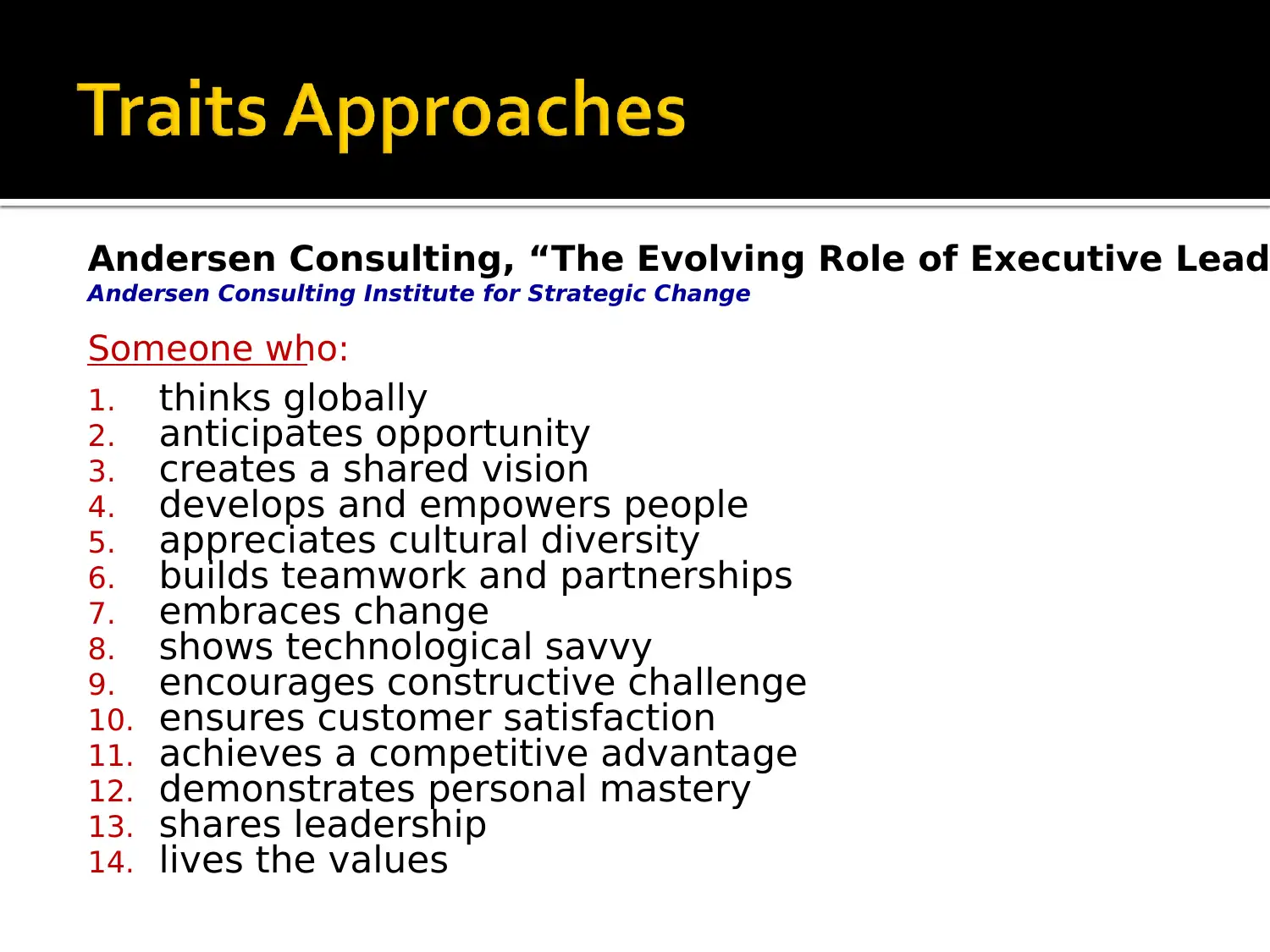
Andersen Consulting, “The Evolving Role of Executive Lead
Andersen Consulting Institute for Strategic Change
Someone who:
1. thinks globally
2. anticipates opportunity
3. creates a shared vision
4. develops and empowers people
5. appreciates cultural diversity
6. builds teamwork and partnerships
7. embraces change
8. shows technological savvy
9. encourages constructive challenge
10. ensures customer satisfaction
11. achieves a competitive advantage
12. demonstrates personal mastery
13. shares leadership
14. lives the values
Andersen Consulting Institute for Strategic Change
Someone who:
1. thinks globally
2. anticipates opportunity
3. creates a shared vision
4. develops and empowers people
5. appreciates cultural diversity
6. builds teamwork and partnerships
7. embraces change
8. shows technological savvy
9. encourages constructive challenge
10. ensures customer satisfaction
11. achieves a competitive advantage
12. demonstrates personal mastery
13. shares leadership
14. lives the values
Paraphrase This Document
Need a fresh take? Get an instant paraphrase of this document with our AI Paraphraser
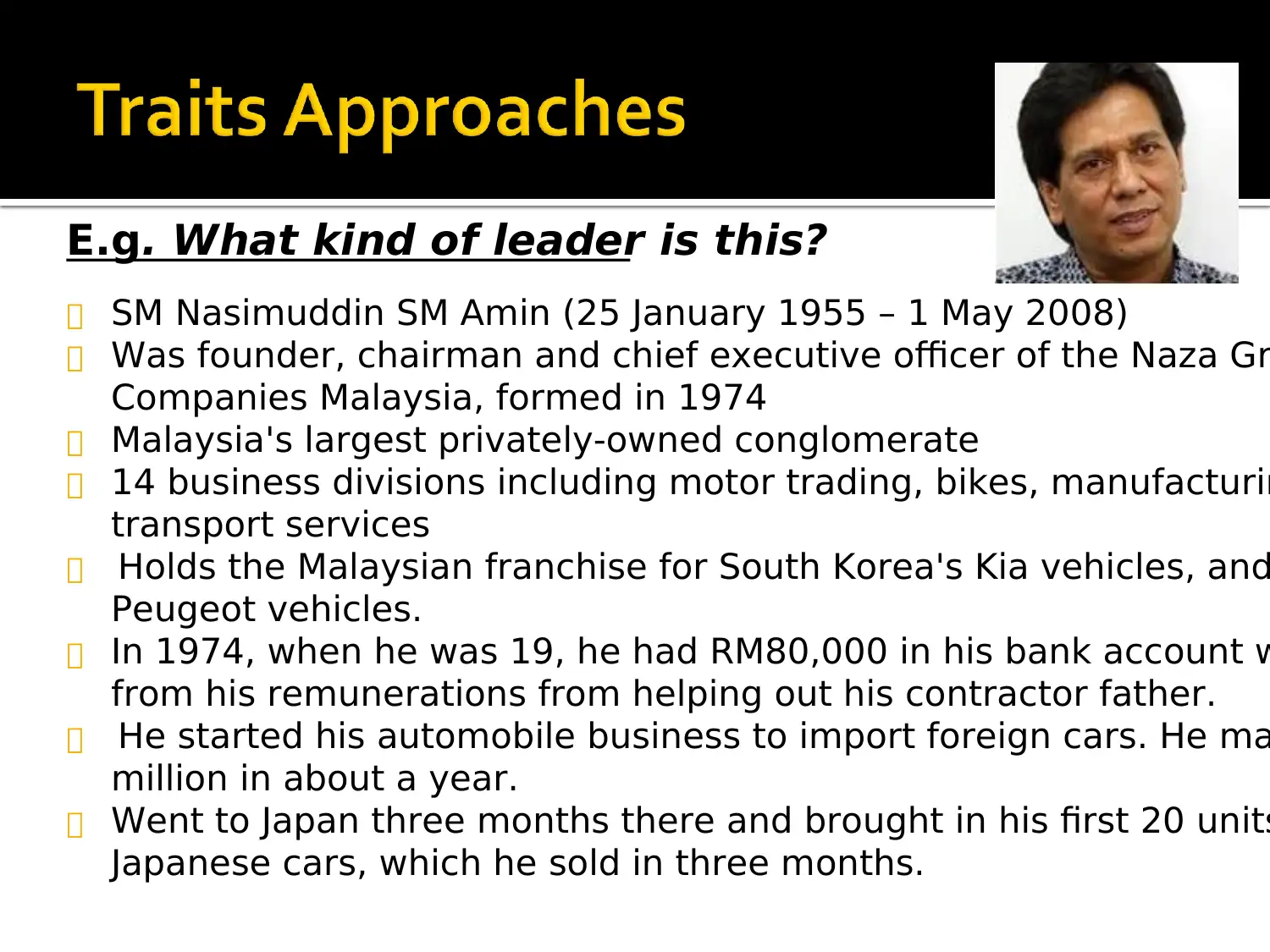
E.g. What kind of leader is this?
SM Nasimuddin SM Amin (25 January 1955 – 1 May 2008)
Was founder, chairman and chief executive officer of the Naza Gr
Companies Malaysia, formed in 1974
Malaysia's largest privately-owned conglomerate
14 business divisions including motor trading, bikes, manufacturin
transport services
Holds the Malaysian franchise for South Korea's Kia vehicles, and
Peugeot vehicles.
In 1974, when he was 19, he had RM80,000 in his bank account w
from his remunerations from helping out his contractor father.
He started his automobile business to import foreign cars. He ma
million in about a year.
Went to Japan three months there and brought in his first 20 units
Japanese cars, which he sold in three months.
SM Nasimuddin SM Amin (25 January 1955 – 1 May 2008)
Was founder, chairman and chief executive officer of the Naza Gr
Companies Malaysia, formed in 1974
Malaysia's largest privately-owned conglomerate
14 business divisions including motor trading, bikes, manufacturin
transport services
Holds the Malaysian franchise for South Korea's Kia vehicles, and
Peugeot vehicles.
In 1974, when he was 19, he had RM80,000 in his bank account w
from his remunerations from helping out his contractor father.
He started his automobile business to import foreign cars. He ma
million in about a year.
Went to Japan three months there and brought in his first 20 units
Japanese cars, which he sold in three months.
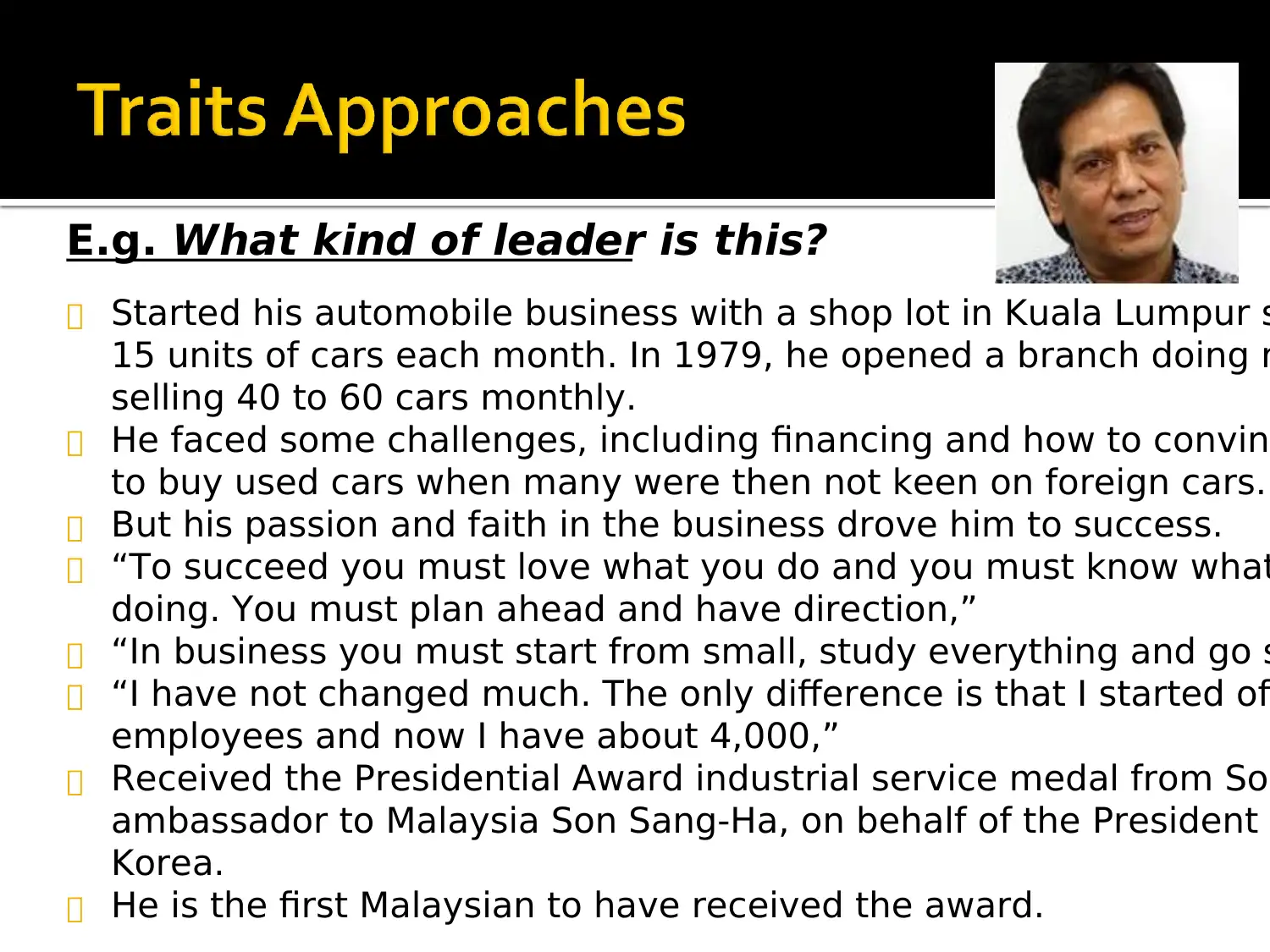
E.g. What kind of leader is this?
Started his automobile business with a shop lot in Kuala Lumpur s
15 units of cars each month. In 1979, he opened a branch doing r
selling 40 to 60 cars monthly.
He faced some challenges, including financing and how to convinc
to buy used cars when many were then not keen on foreign cars.
But his passion and faith in the business drove him to success.
“To succeed you must love what you do and you must know what
doing. You must plan ahead and have direction,”
“In business you must start from small, study everything and go s
“I have not changed much. The only difference is that I started off
employees and now I have about 4,000,”
Received the Presidential Award industrial service medal from Sou
ambassador to Malaysia Son Sang-Ha, on behalf of the President o
Korea.
He is the first Malaysian to have received the award.
Started his automobile business with a shop lot in Kuala Lumpur s
15 units of cars each month. In 1979, he opened a branch doing r
selling 40 to 60 cars monthly.
He faced some challenges, including financing and how to convinc
to buy used cars when many were then not keen on foreign cars.
But his passion and faith in the business drove him to success.
“To succeed you must love what you do and you must know what
doing. You must plan ahead and have direction,”
“In business you must start from small, study everything and go s
“I have not changed much. The only difference is that I started off
employees and now I have about 4,000,”
Received the Presidential Award industrial service medal from Sou
ambassador to Malaysia Son Sang-Ha, on behalf of the President o
Korea.
He is the first Malaysian to have received the award.
⊘ This is a preview!⊘
Do you want full access?
Subscribe today to unlock all pages.

Trusted by 1+ million students worldwide
1 out of 41
Your All-in-One AI-Powered Toolkit for Academic Success.
+13062052269
info@desklib.com
Available 24*7 on WhatsApp / Email
![[object Object]](/_next/static/media/star-bottom.7253800d.svg)
Unlock your academic potential
Copyright © 2020–2025 A2Z Services. All Rights Reserved. Developed and managed by ZUCOL.

